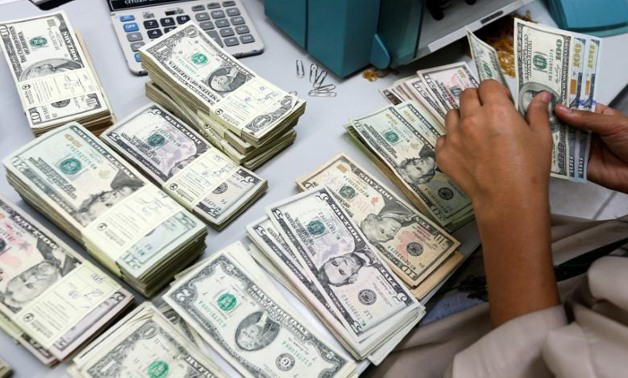
A bank employee counts U.S. dollar notes- Reuters photo
CAIRO – 7 September 2017: Egypt’s international reserves rose $11.8 billion over the past eight months, an official at the Central Bank of Egypt (CBE) said Wednesday.
Speaking to Egypt Today, the official, who requested to remain anonymous, said that the CBE’s plan to build up foreign assets has succeeded in covering worth of seven months of imports.
“The increase is reflecting an improvement in Egypt’s dollar resources (hard currency resources), in addition to restoring the confidence of foreign investors in the economy, which appeared in the influx of foreign investment in government’s debt tools,” the source added.
The CBE announced Wednesday that Egypt’s foreign reserves hiked $100 million by the end of August to reach $36.1 billion, up from $36 billion in July.
In June, Egypt's foreign reserves jumped by $4.73 billion to $36.04 billion, recording the highest level since the January 2011 revolution.
Foreign reserves in the CBE have been rising since the Egyptian government clinched a $12 billion three-year loan from the International Monetary Fund (IMF) in November, after Cairo started implementing an ambitious economic reform plan by floating the Egyptian pound, introducing a value added tax and slashing energy subsidies.
The banking sector has collected $47 billion since the flotation from the foreign trade transactions, CBE’s sub-governor Tarek Fayed said last month.
Floating the Egyptian pound has caused a breakthrough in resources of the foreign currency.
Egypt issued $7 billion in Eurobonds sales in January and May on the global bond market, which were both oversubscribed, as announced by the Ministry of Finance in time.
Remittances from expatriate workers abroad hiked11.1 percent ($930 million) to hit $9.3 billion over the six month period following the flotation (from November 2016 to April 2017), up from $8.3 billion in the same period last year, CBE said in June.
For the whole fiscal year 2016/17, remittances registered $17.4 billion, inching up two percent, according to initial data obtained by Bloomberg in August.
Egypt’s once main source of foreign reserves tourism revenues jumped 170 percent in the first seven months of 2017, reaching $3.5 billion, a government official told Reuters this week.
The number of tourists visiting Egypt rose 54 percent in the same seven-month period on an annual basis to reach 4.3 million, the government said, attributing the increase to visitors from Germany and Ukraine.
Tourist revenues should hit $6 billion in 2017, up from $3.4 billion in 2016, the official added.
As for the Suez Canal, the waterway’s revenues in 1H 2017 registered $2.938 billion, up from $2.919 billion, chairman of the Suez Canal Authority Mohab Mamesh said in a statement, explaining that more than 9,900 ships crossed the canal during that period, compared to 9,745 ships in 1H 2016.
Following the liberalization of the local currency, Egypt’s exports became more competitive, rising to $11.1 billion, allowing the government to decrease trade deficit 46 percent over the first half of 2017.
In that period, the trade deficit recorded $11.13 billion, down from $24 billion in the year-ago period, according to the ministry’s foreign trade statistics.
The ministry reasoned the deficit drop to higher exports by eight percent to reach $11.13 billion in the first six months of 2017 compared to $10.29 billion in the same period of the previous year.
On the other hand, imports leveled down 30 percent to $24 billion in H1 of 2017, compared to $34 billion in H1 of 2016, encouraged by some procedures, including eliminating low-quality imports, achieving the target from the exports’ development plan, rationalizing imports, preserving the hard currency and depending on the local products.

Comments
Leave a Comment